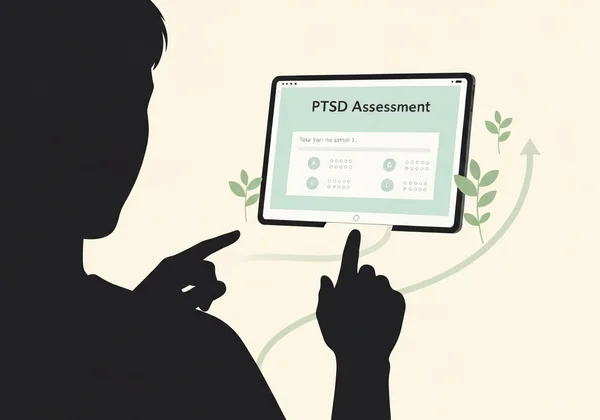Is It Burnout or PTSD? Take Our Free PTSD Test Online for High-Stress Workers
In demanding professions, immense pressure is a given. But how do you tell if that persistent exhaustion is just burnout, or something deeper—like Post-Traumatic Stress Disorder (PTSD)? For veterans, first responders, and healthcare workers, understanding this distinction isn't just theory; it's vital for your mental health. This guide will clarify the distinctions and overlaps between burnout or PTSD, empowering you to identify your symptoms accurately. If you're wondering, how do you know if you have trauma?, understanding these differences is a critical first step.
The weight of high-stakes work can be isolating, but you don't have to navigate this uncertainty alone. Gaining clarity can be the start of your path toward feeling like yourself again. An initial step could be a confidential PTSD assessment to better understand your experiences.

Understanding Professional Burnout: More Than Just Stress
Burnout is a state of emotional, physical, and mental exhaustion caused by prolonged or excessive stress. More than just a bad week, it's a gradual process of feeling overwhelmed and emotionally drained, often tied directly to your job. Unlike PTSD, burnout is not classified as a mental disorder in the DSM-5 but is recognized as an occupational phenomenon. It stems from chronic workplace stress that has not been successfully managed.
Recognizing Key Symptoms of Burnout
The World Health Organization (WHO) defines burnout by three primary dimensions. Understanding these signs is the first step in identifying if what you're feeling is related to job stress.
- Feelings of energy depletion or exhaustion: This is more than just feeling tired. It's a deep-seated fatigue that isn't relieved by a weekend of rest. You might feel physically and emotionally drained every day.
- Increased mental distance from one’s job, or feelings of negativism or cynicism related to one's job: You may start to feel detached from your work, your colleagues, and the people you serve. The passion or purpose you once had may be replaced by cynicism and dread.
- Reduced professional efficacy: Despite putting in long hours, you might feel like you’re not accomplishing anything. This can lead to a crisis of confidence and a sense of failure.
Causes of Workplace Burnout
Burnout doesn't happen overnight. It often results from a persistent mismatch between the demands of a job and the resources available to the individual.
Common triggers include an unmanageable workload, a lack of control over your work, insufficient rewards for your effort, and a breakdown of community or support in the workplace. For those in high-stress roles, constant exposure to pressure without adequate time for recovery is a primary driver. If these symptoms resonate, it's important to acknowledge them, but it's also crucial to see if there's more to the story.

PTSD in High-Stress Professions: Recognizing Trauma's Mark
Post-Traumatic Stress Disorder (PTSD) is different. It is a mental health condition triggered by a terrifying event—either experiencing it or witnessing it. While burnout is a response to chronic stress, PTSD is a direct response to trauma. For professionals on the front lines, the line between job stress and trauma can be blurry. A single critical incident or repeated exposure to distressing events can leave a lasting mark.
A PTSD self-test can be a valuable tool for privately exploring whether your symptoms align with those of PTSD.
Core PTSD Symptoms
The symptoms of PTSD are generally grouped into four types, and they often manifest in ways that directly impact your ability to function in a high-risk role.
- Intrusive Memories: This can include recurrent, unwanted distressing memories of the traumatic event, flashbacks where you feel as if the event is happening again, or vivid nightmares.
- Avoidance: You might go out of your way to avoid reminders of the traumatic event. This could mean avoiding people, places, activities, or conversations that bring the memories back.
- Negative Changes in Thinking and Mood: This can manifest as persistent negative thoughts about yourself or the world, feelings of hopelessness, memory problems (including not remembering important aspects of the event), and feeling detached from family and friends.
- Changes in Physical and Emotional Reactions (Arousal): Also known as hypervigilance, this includes being easily startled, always feeling "on guard" for danger, having trouble sleeping, irritability, angry outbursts, or overwhelming guilt and shame.
Specific Traumatic Events for High-Stress Roles
For first responders, healthcare workers, and military personnel, the definition of a traumatic event is broad. It's not just a single, catastrophic incident. It can be the cumulative effect of many smaller, deeply impactful events—a phenomenon sometimes related to Complex PTSD (cPTSD). This could include responding to a fatal accident, losing a patient, or witnessing violence. Repeated exposure to suffering can erode one's sense of safety and control, paving the way for PTSD symptoms.

Burnout vs. PTSD: Key Differences and Overlaps
While both burnout and PTSD can leave you feeling exhausted, detached, and emotionally raw, their origins and core features are fundamentally different. Pinpointing these distinctions is vital for finding the right path forward. The main question to ask is: are my symptoms a reaction to overwhelming chronic stress, or are they tied to a specific traumatic experience?
A Comparative Checklist of Symptoms
To help clarify, consider this breakdown.
Burnout is primarily characterized by:
- Origin: Chronic, unmanaged workplace stress.
- Core Emotion: Exhaustion, cynicism, and a sense of inefficacy.
- Scope: Primarily related to your professional life, though it can spill over.
- Key Symptoms: Feeling drained, mentally distant from the job, and underperforming.
PTSD is primarily characterized by:
- Origin: Exposure to a specific traumatic event or series of events.
- Core Emotion: Fear, helplessness, and horror.
- Scope: Pervasive, affecting all areas of life, not just work.
- Key Symptoms: Re-experiencing the trauma (flashbacks, nightmares), avoidance of reminders, hypervigilance, and negative mood.
There can be overlap. Both can cause sleep disturbances, irritability, and difficulty concentrating. However, the intrusive thoughts and hyperarousal specific to PTSD are not features of burnout. If you suspect your symptoms go beyond burnout, consider taking a free PTSD test.

The Deciding Factor: A Traumatic Event
This is the most critical distinction. Burnout develops over time from the pressure of the job itself. PTSD is directly linked to a traumatic event as defined by the DSM-5. You cannot have PTSD without a trauma history. The feelings of being on edge, the flashbacks, and the need to avoid reminders are all tied back to that specific moment or period. If your symptoms are anchored to a "before and after" point related to a traumatic incident, PTSD is a more likely explanation.
Why Accurate Identification Matters: Taking a PTSD Test for Your Well-being
Telling the difference between burnout and PTSD isn't just an academic exercise; it's essential for your recovery. The strategies for managing burnout are very different from the evidence-based treatments for PTSD. Misidentifying the problem can lead to frustration when coping mechanisms don't work, potentially worsening your symptoms over time.
Guiding Your Path to Recovery
Properly identifying your condition ensures you seek the right kind of help.
- For Burnout: Recovery often involves setting boundaries, taking time off, changing your work environment, or developing better stress-management skills. The focus is on restoring energy and re-engaging with your work in a healthier way.
- For PTSD: Recovery requires trauma-focused therapies like Cognitive Behavioral Therapy (CBT) or Eye Movement Desensitization and Reprocessing (EMDR). These treatments help you process the traumatic memories so they no longer control your life.
Using the wrong approach can be ineffective. Taking a vacation won't resolve trauma-related flashbacks, and stress management techniques alone are often insufficient for PTSD.
When to Consider a PTSD Assessment
If you've read this and find yourself identifying with the symptoms of PTSD—especially the intrusive memories and hypervigilance—it is time to consider a more formal assessment. Your experiences are valid, and understanding them is a sign of strength.
An online PTSD screening test is a completely confidential and accessible first step. It can provide immediate insights based on established criteria like the PCL-5, helping you organize your thoughts before speaking with a healthcare provider.
Taking the First Step Towards Understanding and Healing
For professionals in high-stress fields, the lines between exhaustion, burnout, and trauma can easily blur. Recognizing that what you're experiencing might be more than just job fatigue is a courageous first step. Differentiating between burnout and PTSD is crucial because it dictates your path to recovery and well-being.
You don't need all the answers immediately. Your first courageous step is simply to seek clarity. Acknowledging your symptoms and beginning to understand them is a powerful act of taking back control.
Ready to gain some insight? Take the test on our homepage. It's free, confidential, and designed to help you understand your symptoms, providing a solid foundation for your next steps toward healing.

Frequently Asked Questions About Burnout and PTSD
How do you tell the difference between burnout and PTSD?
The primary difference lies in the cause and core symptoms. Burnout is a response to chronic workplace stress, characterized by exhaustion and cynicism. PTSD is a response to a specific traumatic event, characterized by intrusive memories, avoidance, and hypervigilance. Ask yourself if your symptoms are tied to a particular traumatic memory; if so, it may point towards PTSD.
Can long-term burnout eventually lead to PTSD?
While burnout itself does not cause PTSD, the chronic stress that leads to burnout can make you more vulnerable to developing PTSD if you experience a traumatic event. A state of constant depletion can weaken your psychological defenses, making it harder to cope with trauma.
How accurate are online tests for workplace trauma and PTSD?
Reputable online PTSD tests, like the one offered on our platform, are based on clinically recognized screening tools such as the PCL-5. They are highly accurate as preliminary screening instruments. While not a formal diagnosis, they provide a reliable indication of whether your symptoms align with the criteria for PTSD, empowering you to have a more informed conversation with a professional. You can explore a PTSD assessment test to see for yourself.
What happens if PTSD or workplace trauma is left untreated?
Untreated PTSD can have severe consequences, impacting relationships, job performance, and physical health. Symptoms may worsen over time, leading to depression, anxiety disorders, and substance use issues. Early recognition and intervention are key to preventing long-term complications and improving your quality of life.
Where can high-stress professionals find support for burnout or PTSD?
Support can be found through employee assistance programs (EAPs), peer support groups for first responders or veterans, and mental health professionals specializing in trauma. Organizations like the National Institute of Mental Health (NIMH) and the Department of Veterans Affairs (VA) offer reliable resources. A confidential first step is often an online tool, which can give you the clarity needed to seek further help.